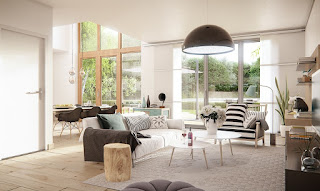There’s nothing quite like the feeling of a freshly spruced space. For those of us who lead busy lifestyles, keeping our homes clean requires daily diligence, but we have a better idea: Become a minimalist. This design trend is all about less is more: Think curated versus cluttered.
Paring things down to the basics and ditching the superfluous can do wonders for your sanity—not to mention it looks super sophisticated and sleek. From monochromatic minimalism to laid-back luxury, this simple approach to interior design is one of our favorites. But just like the no-makeup makeup trend, it’s not as simple as it looks. If you’ve been a longtime fan of the look but are unsure about how to get started, our step-by-step approach to minimalist design will help you kick things off.
Clear All Surfaces of Clutter
Look around: What do you see? If it’s anything like our surroundings, there are piles of paper (mostly bills and junk mail), car keys, shoes around the front door, empty cups, sunglasses, and random objects that somehow made their way from our bag to the kitchen counter. And that’s just the beginning. The dining table is another surface that tends to be a clutter magnet.
If you truly want to embrace the minimalist design look and feel, these need to be cleared, stat. Ask yourself what can be eliminated, what can be stored out of sight, and what items aren’t essential; then organize according to priority. Be consistent with this process and come back to each room every few months with a fresh set of eyes. You’ll find there’s more you can simplify each time. To make sure your surfaces stay clear, give everything a special spot and stick to it.
Create a Neutral Base
When creating a classic minimalistic interior, it’s all about the base color. Subdued hues rule here—from biscuit to greige and every ecru-inspired tone in between. Why? It’s clean, fresh-looking, and inspires a sense of calm. But just because classic minimalism tends to be color-averse, it doesn’t have to be bland or boring. In fact, minimalism at its finest is quite the opposite.
If you want to introduce some color, be sure to choose solid pigments that are easy on the eyes and fuse well with the neutrals, such as earth-tone browns, blues, tans, and greens.
Choose Quality Over Quantity
The challenge of working within the pared-back aesthetic is how little you actually have to work with. This makes the decision process even trickier than usual. You really have to consider each piece carefully before it enters the room, but this also means the end result is elegantly curated. Your goal is to create a space that anyone would want to spend time in.
In this case, it truly pays to buy quality over quantity and invest in classics that will stand the test of time (and spark your interest). Impulse buys on trendy items that you’ll tire of quickly doesn’t work with minimalist design. Choose well-made pieces that are built to last, will withstand daily use, and look better as a result. Patina is everything.
Live By the One In, One Out Philosophy
It’s astonishing how much one person can acquire in a short span of time. The empty kitchen drawers, bedroom closet, and bathroom cupboards from when you first moved in are suddenly full of nonessentials and unused products that are now collecting dust. Even when you can’t see it, this “stuff” is cluttering your headspace and taking up valuable room in your home. It’s time to clear out that junk drawer.
To prevent this dilemma from happening at all, we recommend putting Colleen Madsen’s “one in, one out” rule into practice.
Use Different Textures in Similar Tones
A minimalistic room with neutral tones can tend to feel cold or bland, but there’s one foolproof trick that remedies this every time: Texture. Turn up the temperature with knitted throws, beaded pillows, sheepskin rugs, and velvet décor for that much-needed comfort factor. While restraint is usually advised, feel free to go wild with these sensory touchpoints (so long as they’re in the same tonal family).
Invest in Stylish Storage
So you’ve cleared the clutter, applied the “one in, one out” rule, and chosen quality over quantity, but there are still a few stragglers hanging around. This is where you get sneaky and invest in stylish storage. Attractive storage allows the chaos to live inside while still appearing chic on the outside. This is great news for those who love the minimalistic look but are true maximalists on the inside. You don’t have to completely forgo your collector past, but the hoarder mindset has got to go.
Prioritize Functionality and Style
Think multi-purpose. “Add nesting tables or benches to a living room to get more seating or surface areas that can be easily stored when they’re not in use,” recommends an ExtraSpace Storage blog post. Or “repurpose an old dresser and turn it into a desk for a bedroom, or put a wooden tray on a bench and use it as both a console table and a place to sit when entertaining guests.”
Accessorize With Restraint
Décor experts say that in minimalist style, each piece should serve a purpose. That might look like accessorizing around your more functional pieces, like your couch or dining table. “The key is to let the rest of your design elements play a supporting role to the furniture, rather than stealing attention away,” . For example, “Focus on choosing pieces that are sleeker, without too much visual weight to them.” Perhaps that could mean opting for a sculptural floor lamp or sconces, or throw pillows in a muted pattern.
Incorporate Natural Elements
Balance the look of white space and sleek lines with natural materials, like a wooden bench for the entryway, or woven baskets that double as storage for your workout equipment or throw blankets. Select a few succulents for a pop of color on your coffee table, or place a potted palm in an empty corner to brighten up the space.
Take Advantage of Natural Light
Avoid the stark and clinical look that the minimalist look can sometimes give off by letting in as much natural light as possible. This will warm up the space and make it feel cozy without adding visual clutter that one too many décor accessories might. Sheer drapes and a strategically placed mirror can help filter and bounce light around a space.
Keep It Simple
Now that you know all the steps to styling a minimalistic home, we want to take this opportunity to reiterate the underlying philosophy behind it: Keep it simple. Tone everything down, pare everything back, and abide by the “less is more” approach. That said, don’t think your new décor has to be boring. When done well, minimalist design can be beautiful, warm, rich, and inviting.









